The History Of FORD Transit
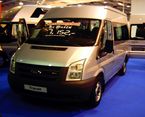
The Ford Transit is a range of panel vans, minibuses and pickup trucks, produced by the Ford Motor Company in Europe.
The Transit has been the best-selling light commercial vehicle in Europe for 40 years, and in some countries the term "Transit" has passed into common usage as a generic term applying to any light commercial van in the Transit's size bracket.[citation needed]
Over 5,000,000 Transits have been produced since 1965 across three basic platforms with several "facelift" versions of each.
Known in Germany as the "first generation" TransitUnlike the British-built Transit "family", the first production Ford to wear the "Transit" badge was a van built in Ford's Köln (Cologne) plant in Germany. It was introduced in 1953 as FK 1000 (Ford Köln carrying 1000kg). From 1961, this vehicle was called the Ford Taunus Transit. Production of this model ceased in 1965.
Naming system
The German vehicle was not widely exported, and the "Mark 1" tag has commonly been applied, retrospectively, to the 1965-78 British model (see below). Whilst there have been three basic Transit platforms since 1965, the various facelifts and upgrades over the years have been referred to using a conflicting range of "Mark" numbers, with some sources counting a facelift as a new "Mark", some not. Ford's own historical look back at Transit production, published for the launch of the 1994 model, avoids the issue by referring to generations of Transit by years produced. Therefore this article attempts to make mention of all the common naming systems.
Origins of the name
Ford had a manufacturing plant in Cork, Ireland up until the mid-1970s. Just after World War II, the proprietor of the local Ford Garage, "The Transit Garage", built a Ford Special, a 2-seater sports car, to compete in the local Cork 20 Rally. This car won the race and was known as the Ford Transit. The name was established, and noted by the management of the local factory. When a name for the commercial van was being sought, the already established name "Ford Transit" was readily available. Complete restoration of the original car was commenced in 2000. In 2007, the car was located in Northern Ireland.[citation needed]
The first Ford Transit proper was introduced in October 1965, and has been in continuous production in three basic generations to the present day. The van was produced initially at Ford's Langley facility in Berkshire, England (a former Second World War aircraft factory which had produced Hawker Hurricane fighters), but as demand outstripped the capability of the plant, production was moved to Southampton, where it has remained ever since. Transits have also been produced in Ford's Genk factory in Belgium and also Turkey. The Transit is also produced in China for the Chinese market.
The Transit was introduced to replace the Ford Thames 400E, a small mid-engined forward control van noted for its narrow track which was in competition with similar looking but larger vehicles from The BMC J4 and J2 vans and Rootes's Commer PB ranges. In a UK market segment then dominated by a Bedford CA offering, because of its restricted load area the Thames failed to win over company users in sufficient numbers, so Ford went back to the drawing board and switched to a front engined configuration, along the lines pioneered during the 1950s by Bedford with their well regarded CA series vans. Henry Ford II's revolutionary step was to combine the engineering effort of Ford of Britain, and Ford of Germany together to create a prototype for the Ford of Europe of today — previously the two subsidiaries had been in direct competition with each other.
The Transit was a huge departure from the European commercial vehicles of the day — its broad track and American-inspired styling gave it a huge advantage in carrying capacity over comparable vehicles of the day and revolutionised light goods transport. Most of the Transit's mechanical components were adapted from Ford's car range of the time. Another key to the Transit's success was the sheer number of different body styles: panel vans in long and short wheelbase forms, pick-up truck, minibuses, crew-cabs to name but a few. The engines used in the UK were the Essex V4 for the petrol engined version in 1.7L and 2.0L capacities, while a 41bhp (31kW) diesel unit sourced from Perkins was also offered. The Perkins diesel engine was too long to fit under the Transit's stubby nose section, which had to be restyled for the diesel version. Producing just 40bhp (30kW), the Perkins unit was not popular, and was replaced by Ford's own "York" unit in 1974. For the mainland Europe the Transit had the German Ford Taunus V4 engine in Cologne 1.7 or Essex 2.0 litre versions.
The long nose front was also used to accommodate the Ford 3.0 litre V6 which was ordered by police and ambulance services.
In Australia, the long-nose diesel front was used to accommodate an inline 6-cylinder engine derived from the Ford Falcon.
In the 1970s according to British police 95% of all robberies involved this type of Ford Transit.
In March 1978, a facelifted version – commonly known in some markets as the "Mark 2" model – debuted with a restyled nose section, new interior, and the introduction of the Pinto engine from the Cortina in place of the Essex V4. However many fleet owners had had bad experiences with premature camshaft wear problems in the early Pinto units in the Cortina and for two years the Transit 75 was available with the 1600cc Ford Kent "Xflo" engine. High performance versions intended for police or ambulance use used the 3.0L V6 version of the Essex engine. In 1984, the York diesel engine was redesigned into the 2.5L "DI" (direct injection) unit. Late in its life this generation received a minor facelift including a black rubberised front grille with integrated headlamp surrounds, which had previously been body-coloured. This facelift did not commonly result in a new "Mark" number being applied.
What proved to be the second generation Transit platform appeared in January 1986 and was notable for its all-new bodyshell which was of "one-box" design (i.e. the windscreen and bonnet are at the same angle), and the front suspension was changed to a fully independent configuration on all but chassis cab and LWB versions. The engine range was carried over largely unchanged from the last of the 1978-85 generation models, although in 1989 the high performance 3.0 V6 petrol was replaced by the Cologne 2.9 EFI V6. A subtle facelift in 1992 saw the fully independent front suspension rolled out across the range, whilst a redesigned floorpan allowed the use of single rear wheels on the LWB derivative, further increasing payload — these models are identifiable by the slightly more rounded front headlamps.
This type of Ford Transit was used in TopGear`s Man With Van Challenge on 30 July 2006 by Jeremy Clarkson who came second behind Richard Hammond. The Challenge consisted of buying a van for under £1,000, a ¼ mile drag race, loading and unloading there van as fast as possible, tail gating a car, changing a door, resisting theft, a police chase and running an advert in a news paper. Richard Hammond came first using a small super carry with 21 points, Jeremy Clarkson second using a Ford Transit with 10.5 points and James May last using a LDV Convoy with -3,999,993 points.
A major facelift to the Transit in 1994/ 5 gave the Transit a new nose and dashboard, along with the 2.0L DOHC 8-valve engine as found in the 1994 - 98 Ford Scorpio. It is similar to the earlier Sierra DOHC unit but without the distributor and uses the updated OBD II-compliant EEC-V level engine control unit. (Some of Ford's 16-valve engines, such as those found in the Scorpio, Escort RS2000 and Galaxy were also based on this block.) At the same time air conditioning, electric windows, central locking, electric mirrors and airbags were all made available as optional extras.
Nickname: “Smiley” because of the grills resemblance of a smiling face.
The turbo diesel version came in 85PS (63kW), 100PS (74kW) and 115PS (85kW) version with a electronic fuel pump.
There were only 600 limited edition Transit Hallmarks ever made.
The next Transit introduced in July 2000 was the third all-new design, and borrowed styling cues from Ford's "New Edge" designs like the Focus, and Ka. Developed by Ford in the United States, the main innovation is that it is available in either front or rear-wheel drive. Ford nomenclature makes this the V184 (RWD) or V185 (FWD) model. This model features the "Puma"-type Duratorq turbo diesel engine also used in the 2000 Mondeo and Jaguar X-Type, with the petrol versions moving up to the 2.3L 16-Valve edition of the straight-4 engine. This Transit can hit 60mph (97km/ h) in 21 seconds and reach a top speed of 93mph (150km/ h), as was shown on the Top Gear television programme in 2005. Top Gear attempted to drive this model around the Nürburgring in 9 minutes 59 seconds, (a time achieved by Jeremy Clarkson driving a diesel powered S type Jaguar in a previous episode) but were unsuccessful.(Maximum power output model. six speed gearbox model)
This version won the International Van of the Year 2001.
The Durashift EST automatic transmission (optional on all rear-wheel drive and standard on the 2.4L, 125bhp (93kW) Duratorq TDdi engines) features controls mounted on the dashboard, a specially adapted manual mode, tow-haul mode, economy mode and winter mode.
Two years later, Ford introduced the Transit Connect, a smaller panel van aimed at replacing the older Escort and Fiesta based models. It shares very little with the full-size Transit in terms of engineering, although is produced alongside the larger van in a new purpose built facility in Turkey.
2002 saw the introduction of the first High Pressure Common Rail diesel engine in the Transit, with the launch of the 125PS (92kW) HPCR 2.0 litre in the FWD.
2004 saw the launch of the first RWD HPCR, the 135PS (99kW) 2.4 litre variant that also introduced the 6-speed MT-82 RWD gearbox.
The five-millionth Transit rolled off the Southampton line on Monday, 18 July 2005 and was donated to an English charity.
In August 2006 the Transit received a facelift to the body, including new front and rear lights, a new front end and a new interior featuring the gearstick on the dashboard as well as incorporating Ford's new corporate radio design. As well as the styling changes, the powertrains were all revised. The old petrol engine was replaced with one from the Ford Ranger. The FWD Diesel went from 2.0 to 2.2 litre capacity and all the diesel engines were now High Pressure Common Rail (Turbo Direct Common Injection) versions. The powertrains were changed to meet new emissions legislation. The new version (Ford nomenclature V347 {FWD} V348 {RWD}) won the International Van of the Year 2007 award despite tough competition from several all-new rivals.
Mid 2006 saw the launch of the "Sport Van", a limited production Van featuring the 130PS (96kW) engine with additional styling parts, "Le Mans" stripes and 18" alloy wheels.
Late 2007 saw the launch of the 140PS (103kW) FWD engine (replacing the 130 PS) complete with the VMT6 6-speed transaxle to cope with the extra power.
The 6-speed transaxle is expected to be introduced on the mid-power FWD in early 2008 when the 110PS (81kW) engine is upped to 115PS (85kW).
To celebrate the Transit's status as International Van of the Year, Ford has built this – the Transit XXL. It is a one-off special that is among the most expensive Transits ever.
The Ford Transit made its debut in the American continent in Mexico on September 10, 2007 and over 9 different models are offered. This is the only country in the American continent in which it is currently on sale. Ford's CEO Alan Mulally has recently determined that the rest of North America will be getting the Ford Transit. Thanks to its four cylinder engine, the Transit is far more fuel efficient than the North American E-Series.
From Wikipedia, the free encyclopedia
More About FORD Transit
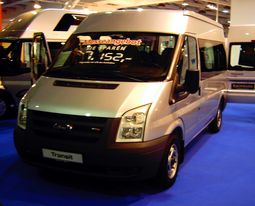
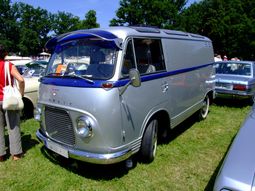
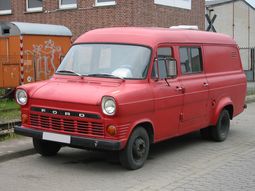
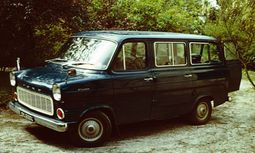
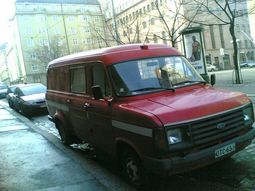
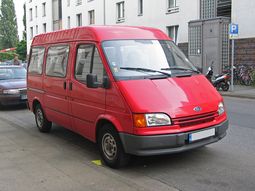
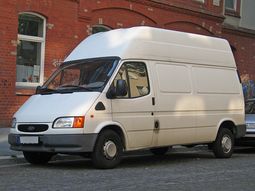
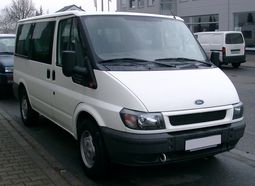
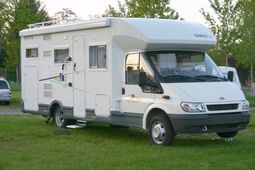
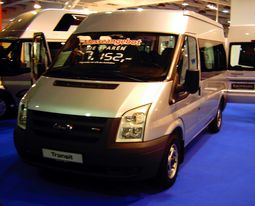
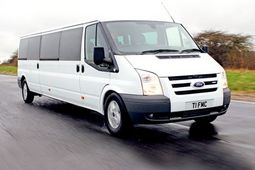
|